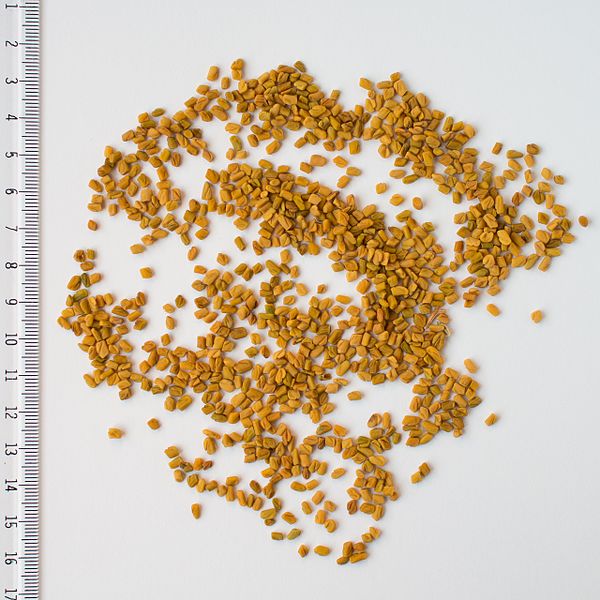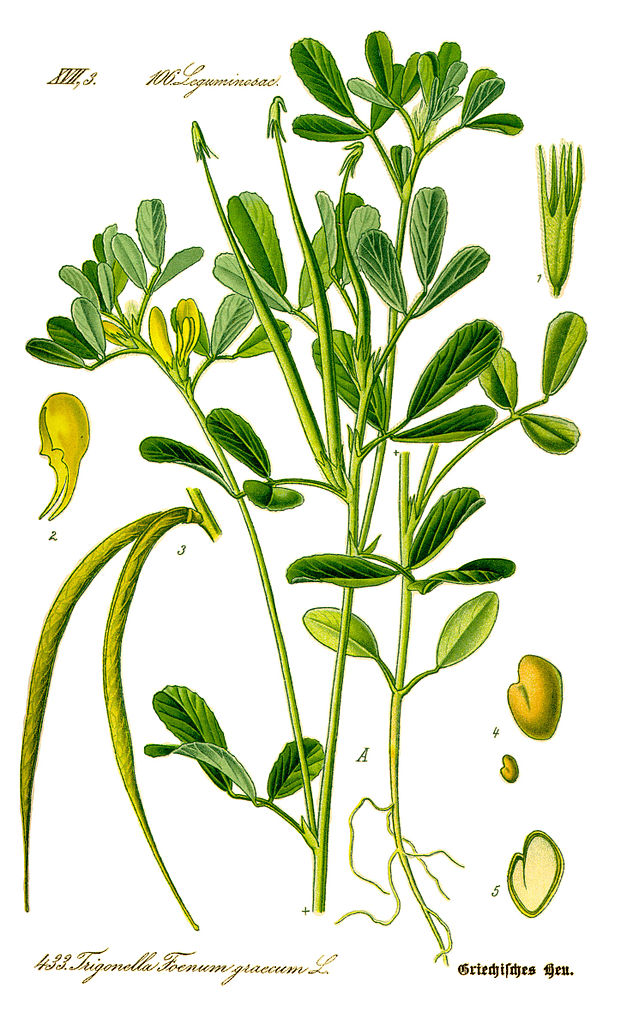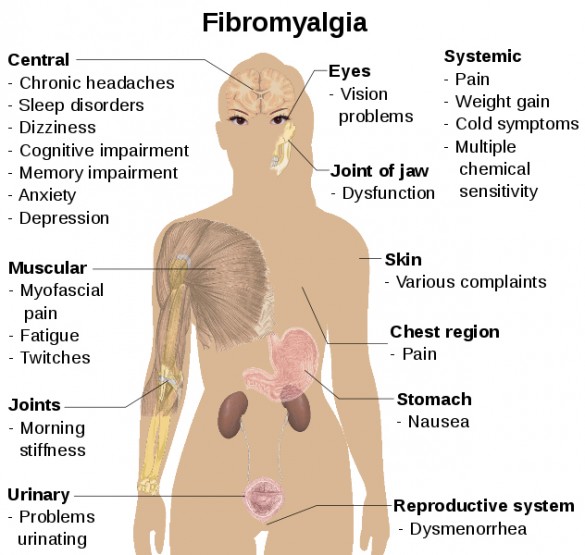Fenugreek is an herb native to southeastern Europe, northern Africa, and western Asia, but is widely cultivated in other parts of the world. Its botanical name is Trigonella foenum-graecum; its English name comes from two Latin words meaning Greek hay. Fenugreek is an annual plant that grows 2–3 ft (0.6–0.9 m) tall, with a strong odor and small pale yellow flowers.
The seed of the fenugreek plant contains many active compounds with pharmaceutical applications. The seeds are collected in the autumn. The chemical components of fenugreek seed include iron, vitamin A, vitamin B1, vitamin C, phosphates, flavonoids, saponins, trigonelline, and other alkaloids. The seed is also high in fiber and protein.
General use
Quite apart from its therapeutic value, fenugreek is used as a seasoning and flavoring agent in foods, particularly in Egypt, India, and the Middle East. The maple smell and flavor of fenugreek have led to its use as a spice in foods, beverages, confections, tobacco, and imitation maple syrup. In some countries, the seeds are eaten raw or boiled, or the greens are enjoyed as a fresh salad. Extracts of fenugreek are used in some cosmetic products as well.
  |
In addition to its use in flavoring foods, the antifungal and antibacterial properties of fenugreek are now being applied to food preservation. In June 2002, a high school student from Maryland was awarded a Lemelson- MIT Invention Apprenticeship for her invention of a food packaging paper made from fenugreek seeds.
The best-documented medical use of fenugreek is to control blood sugar in both insulin-dependent (type 1) and noninsulin-dependent (type 2) diabetics. Some studies also show that serum cholesterol levels in diabetics, and perhaps in others, are reduced by fenugreek. Doses as low as 15 mg per day may produce beneficial effects on fasting blood sugar, elevation of blood sugar after a meal, and overall glycemic control.
The use of fenugreek is likely to alter the diabetic patient’s need for insulin or other medications used to control blood sugar. This treatment should be supervised by a health care provider familiar with the use of herbal therapies for diabetes. The recommended doses of fenugreek can vary rather widely.
The seeds of fenugreek can also act as a bulk laxative as a result of their fiber and mucilage content. These portions of the seed swell up from being in contact with water, filling the bowel and stimulating peristaltic activity. For laxative purposes, 0.5–1 tsp of freshly powdered herb per cup of water, followed by an additional 8 oz water, can be taken one to three times daily. Patients should begin with the lowest effective dose of fenugreek; they should also avoid taking oral medications or vitamins at the same time as the herb.
Capsules of fenugreek seed are sometimes recommended as a galactogogue, or agent to increase milk production in the lactating mother. This use of the herb should be undertaken cautiously, since the evidence of safety for the nursing infant is only anecdotal. Some commercial teas promoted for the purpose of increasing lactation use fenugreek as an ingredient, but herbal concentration in teas can vary widely and are generally somewhat low.
There is some evidence that internal use of fenugreek seed can decrease some stone-forming substances in the kidney, particularly calcium oxalate. Patients who are prone to this type of kidney stone may wish to consult a health care provider about the advisability and dose of fenugreek seed for this use.
Fenugreek may encourage a flagging appetite, and is sometimes given during convalescence from illnesses to improve food intake, weight gain, and speed of recuperation.
   |
Cancer researchers are also studying fenugreek for its potential effectiveness as a cancer chemopreventive. It is thought that fenugreek may help to prevent cancer by raising the levels of vitamin C, vitamin E, and other antioxidants in the bloodstream.
Historically, fenugreek has been used as a topical treatment for abscesses, boils, burns, eczema, gout, and ulceration of the skin as it has an anti-inflammatory effect. It is also reputedly useful for a number of digestive complaints, including gastritis and gastric ulcers.
A study published in 2002 found that both an aqueous solution and a gel fraction derived from fenugreek have anti-ulcer effects comparable to those of omeprazole, a standard medication given to reduce gastric secretions. The researchers found that the fenugreek solution protected the gastric mucosa from injury as well as reducing the secretion of gastric acid.
Fenugreek reportedly can be helpful in the induction of childbirth, as it is known to stimulate uterine contractions. For this reason it should not be taken during pregnancy. As a gargle, fenugreek may relieve sore throats and coughing. Arthritis, bronchitis, fevers, and male reproductive conditions are other traditional but unsubstantiated indications for this herb.
 |
| Fenugreek seeds |
Preparations
Fenugreek may be purchased as bulk seeds, capsules, tinctures, or in teas. Due to the strong, bitter taste, capsules are used most often. The dose is variable, depending on the form of the herb that is used. The seeds may also be soaked to make a tea. For topical use, powdered fenugreek seed is mixed with water to form a paste. Herbal supplements should be stored in a cool, dry place, away from direct light and out of the reach of children.
Precautions
Fenugreek may, when taken in larger amounts than are used to season foods, cause contractions of the uterus. For this reason, women who are pregnant should avoid therapeutic doses. Frequent topical use of fenugreek preparations may cause skin irritation and sensitization. Symptoms of allergic reaction include swelling, numbness, and wheezing. This herb should not be used by anyone with sensitivity to fenugreek.
Large doses (over 100 g per day) may cause intestinal symptoms, including diarrhea, nausea, and gas. Blood sugar can also drop to abnormally low levels. Fenugreek is generally recognized as safe, but its safety is not well-documented for use in small children, lactating women, or persons with liver or kidney disease.
Side effects
Depending on the dose used, fenugreek may cause a maple syrup odor in the patient’s sweat and urine.
Interactions
Fenugreek can enhance anticoagulant activity, and should not be used with other herbs or medications (heparin, warfarin, ticlopidine) that have this effect due to increased risk of bleeding. It can lower blood sugar to a marked degree; blood sugar levels should be monitored closely, particularly in people who are taking insulin, glipizide, or other hypoglycemic agents. Medications that are being taken to control diabetes may need to have dosages adjusted, which should be done under medical supervision.
In theory, since fenugreek is high in mucilage, it can alter the absorption of any oral medication. Corticosteroid and other hormone treatments may be less effective. Monoamine oxidase inhibitors (MAOIs) may have increased activity when used in conjunction with fenugreek.




























